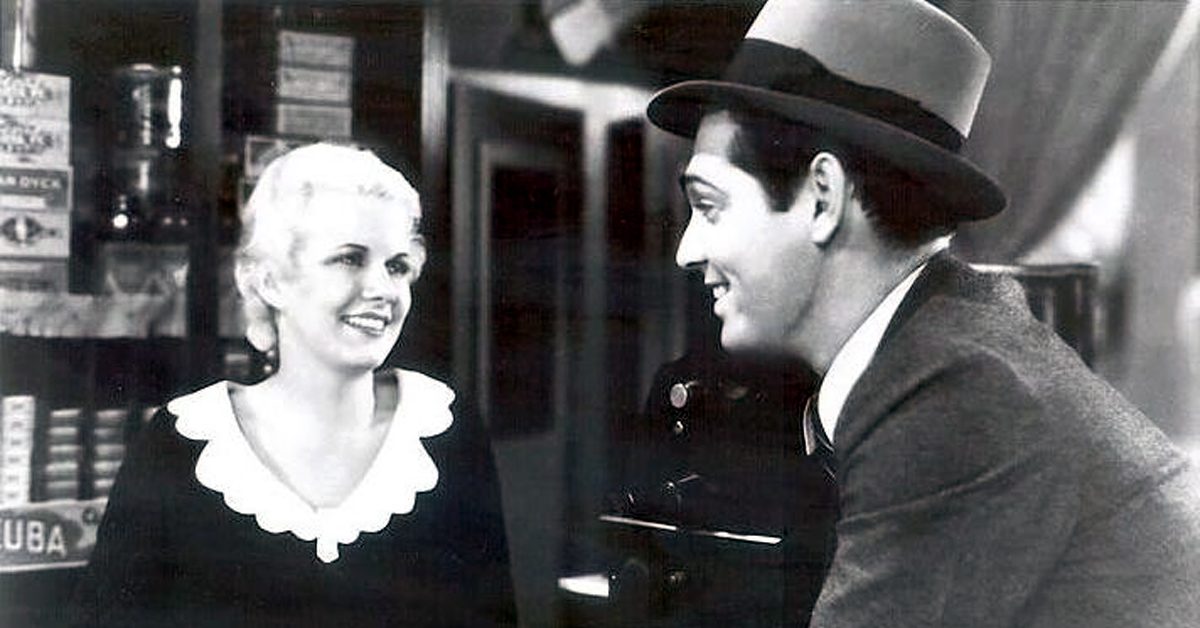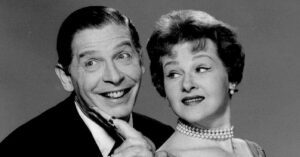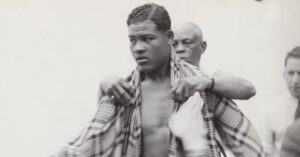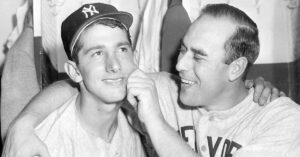THE SECRET SIX (1931) is a ruthless gangster saga featuring a powerhouse cast, some on the way up, one on the way down. Two stars on the way up in this underworld drama were Clark Gable and Jean Harlow.
Hugh Hefner financed a documentary called WITHOUT LYING DOWN on the life screenwriter Frances Marion. She was married to but separated from filmmaker George Hill. She wrote THE SECRET SIX. He directed it. They were Mr. And Mrs., but living apart.
Most of Frances Marion’s original stories and screenplays were written before Oscars were conferred for crafting them. She did win successive Academy Awards, however, for pictures made shortly before and THE SECRET SIX: THE BIG HOUSE (1930) and THE CHAMP (1931) – both starring the hulking brute of a man THE SECRET SIX was built around, Wallace Beery.
THE BIG HOUSE was also directed by Frances Marion’s husband, George Hill. The pair made several films together. Hill was highly competent, and died much too young, in 1934. He was preparing to direct the Oscar-nominated GOOD EARTH when he was found dead in his beach house. Apparently, he killed himself over the estrangement from Frances Marion.
Prohibition ushered in a cycle of gangster movies. Warner Bros. made the best racket dramas: PUBLIC ENEMY (1931) and LITTLE CAESAR (1930). Howard Hughes produced SCARFACE (1932). Fox contributed QUICK MILLIONS (1931).
Metro-Goldwyn-Mayer answered with BEAST OF THE CITY (1932) and the least remembered of them all, THE SECRET SIX. Its genesis: Metro’s production chief Irving Thalberg had asked Frances Marion to create yet another star vehicle for big, gruff old Wallace Beery, because audiences flocked to see his movies. Marion was inspired to write her screenplay after reading a true story in the SATURDAY EVENING POST about six civic-minded crusaders who would combat crime, as a committee, in secret.
In the account fashioned by Frances Marion, the six vigilantes wear Batman-like masks, the kind of thing one would have seen in silent serials all the time. The disguise may look foolish or silly today, but audiences in 1931 were accustomed to such dramatics. Marion patterned her lead mobster after Chicago’s notorious gangland boss, Al Capone. Chicago and Cicero, Illinois are clearly the setting for her story.
The “beast” of THE BIG HOUSE, and THE CHAMP, and any domain he surveyed around the jungle which comprised the M-G-M studio lot, was growling, rubbery-looking Wallace Beery. He often played gross, crude, huge, slow thinking thugs – but with a twinkle. Beery was not well liked by other Metro contract players. Jean Harlow made several big films with Beery, beginning with this one. Although they shared the same hometown of Kansas City, the two loathed and despised each other. When Harlow was called upon to say almost exactly that in the script for THE SECRET SIX, she wasn’t acting.
She hadn’t learned yet to act anyway, and in this instance she didn’t have to.
Off-screen Beery was coarse and violent like his film roles. Harlow was beloved by everyone and in her private life was the opposite of her early, vulgar screen persona, on display here.
It was Harlow’s future-husband, the tragic figure Paul Bern, who arranged with Howard Hughes to borrow her services for THE SECRET SIX. She was billed in the middle of the cast listing, and above Clark Gable. This was the first of their six films together. She was nineteen, he was twenty-nine (an age Harlow would not live to see). Within a matter of months they would be two of the hottest and most enduring movie stars in the industry’s history.
Later, Gable, who was awarded his M-G-M term contract as a result of this effort, commented about working with Harlow here for the first time. “Neither of us knew much about the business,” reflected Gable. “At the end of every scene she would ask me, ‘How’m I doing?’ And I would ask her the same.”
The film’s assistant director, Joseph Newman, agreed with Gable’s assessment. “She was quite an amateur,” Newman said of Harlow. “But she was bright, astute, and observant. You could see it right away.”
THE SECRET SIX marked the film debut of stage actor Ralph Bellamy. It was only one of a dozen motion pictures Gable appeared in during that terrible Depression year of 1931. The two newcomers had dinner together one night. As reported in Bellamy’s autobiography, Gable asked for Bellamy’s opinion of what they were doing, and how he thought things were going in Hollywood.
“I don’t know yet,” Bellamy answered. “I haven’t been here long enough to form an opinion.”
“I just got $11,000 for playing a heavy in a [pre-Hopalong Cassidy] Bill Boyd western,” the mustache-less Gable exclaimed. “Eleven thousand dollars!” he went on in disbelief. “No actor’s worth that. This can’t last. I’ve got myself a room at the Castle Argyll [an inexpensive hostelry at the top of Vine Street] and a secondhand Ford. I’m socking away everything I can and I’m not buying anything I can’t put on The Chief. This just can’t last.”
And yet it did. Frances Marion saw potential in Gable. As the Metro braintrust assessed the rushes each day, it was Marion who suggested scripting new and bigger scenes for Gable to expand and build up his small part. Which happened to be Gable’s first ever good guy role, and also his first of many parts as a news reporter.
It would seem this strategy involving Gable worked wonderfully well for all concerned, except third-billed former All-American halfback at the University of Alabama, Rose Bowl hero John Mack Brown. In their scenes together Gable so overpowered the younger twenty-six year old Brown that it forecast the actor’s gradual decline and end of his contract with M-G-M. By 1935 and into the 1950s Johnny Mack Brown was reduced to fronting low budget although solid and entertaining Saturday matinee westerns for Universal Pictures and poverty row outfits Supreme and Monogram.
Principal photography on THE SECRET SIX took place in January of 1931 and spilled over into the following month. The domestic release date was April 18. Booking delays were caused by negotiations with regional censor boards. THE SECRET SIX caused no little furor of notoriety over its content. New Jersey was one of several states which refused to clear the picture for exhibition!
VARIETY, the show-biz bible, disliked it, calling THE SECRET SIX “a gangster talker too rough, crude and familiar. In big cities it may pull the roughneck trade…but the vocalized expression for it will be adverse….How Metro could forego calling THE SECRET SIX ‘THE SECRET SEX’ is more remarkable than anything in the picture.”
In the opinion of LONDON FILM WEEKLY, “A more appropriate title for this ruthless underworld story would be SLAUGHTERHOUSE, the grim nickname of (Wallace Beery’s character)….It is a splendid, uncompromising performance in which nothing has been spared to achieve realism.”
From the review in THE NEW YORK POST: “The picture is unusually well-directed and it moves with a pulsating speed.”
PHOTOPLAY: “You will see exactly how liquor is made; you will witness the most thrilling gangster chase ever filmed. Beautifully produced and directed by George Hill. Cast is splendid….No, gangster pictures are not dead – not as long as they produce thrillers like this!”
The numbers: $494,000 was the total negative cost. The worldwide gross amounted to $994,000, generating a net profit of $148,000. This constituted a huge 30% return on investment. And yet M-G-M produced a series of shorts titled CRIME DOES NOT PAY. Really, it doesn’t?
This relatively forgotten underworld thriller grossed more money than each of SCARFACE, LITTLE CAESER, BEAST OF THE CITY, and even PUBLIC ENEMY!
On April 29, 1931, eleven days following the issuance of THE SECRET SIX, VARIETY reported on the activities of someone else on the way up, another gangster, a real one, with this news item: “Adolf (sic) Hitler, leader of the nationalistic party, may go into film production in Munich.”
It was April, it was Springtime, for Hitler, in Germany. Marching to a faster pace, look out here comes the master race, as Mel Brooks would later script it for THE PRODUCERS (1967), earning himself an Oscar.
Maybe Wallace Beery wasn’t such an awfully crude fellow after all.




